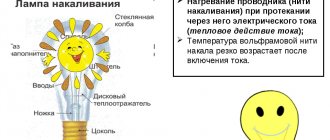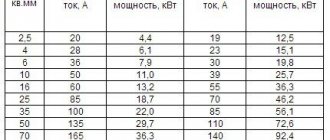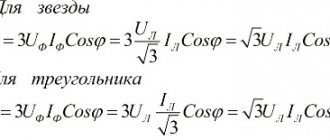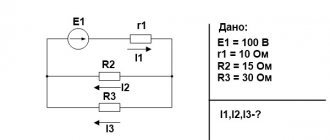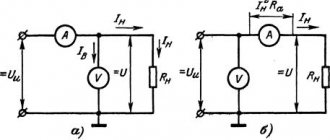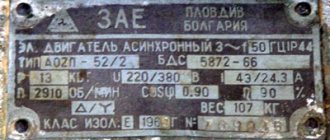Practical significance
Transformation ratio
In the electric power industry, when designing cos networks, the phi coefficient is sought to be increased as much as possible. The ratio cos angle fi implies that if it is small, it will be necessary to use a very high electric current to provide the required power to the circuit. There is a correlation between the use of high current and energy losses in the supply cables: if the electric meter readings are noticeably higher than expected, always check the correctness of the phi angle calculations.
The indicator can be determined using a special device - a phase meter. If the coefficient is insufficient, amplifiers and other installations are used to compensate for energy losses. If the phi angle is calculated incorrectly, there will be a decrease in the efficiency of electrical equipment and an increase in energy consumption.
Phase shift between voltage and current
Ripple factor
Phase shift is an indicator that describes the difference between the initial phases of two parameters that tend to change over time at the same rates and periods. It is the shift between force and stress that determines how much the phi angle will be.
In the radio engineering industry, chains are used to obtain asynchronous operation. One RC circuit creates a 60-degree shift; to obtain a 180-degree shift for a three-phase structure, three circuits are connected in series.
When transforming the electromotive force in the secondary windings of the device, for all current variations, its value is identical in phase to that for the primary winding. If the transformer windings are turned on in antiphase, the voltage value receives the opposite sign. If the voltage follows a sinusoid, a shift of 180 degrees occurs.
In a simple case (for example, turning on an electric kettle), the phases of the two indicators coincide, and they reach peak values at the same time. Then, when calculating consumer power, it is not necessary to use the phi angle. When an electric motor with a composite load containing active and inductive components is connected to alternating current (washing machine motor, etc.), the voltage is immediately applied to the windings, and the current lags due to the action of inductance. Thus, a shift occurs between them. If the inductive component (windings) is replaced by the use of chemical advances in the form of a capacitive battery, the lagging value, on the contrary, is voltage.
Cosine phi should not be confused with another indicator calculated for complex loads - the damping coefficient. It is widely used in power amplifiers and is equal to the partial nominal resistance of the device and the output resistance of the amplifier.
Phase shift angle
Usage
Capital Φ
- Magnetic flux in physics. Also often streams of other vector fields (if it is necessary to distinguish between streams of different fields, an index is added);
- Radiation flux and luminous flux in physics;
- Work function in physics;
- Cumulative distribution function of the normal distribution in probability theory and statistics.
Lowercase φ
- Golden ratio φ = 1.618... in mathematics, art and architecture.
- Euler's function φ( n
) in number theory, as well as the designation of an arbitrary function. - Angle, in particular: complex number argument;
- oscillation phase;
- in the polar coordinate system - the angle with the polar axis;
- in spherical coordinates - most often - the angle of projection of the radius vector onto the xy
with the
x
. - in geography, cartography, navigation - latitude.
Capacity Triangle
The coefficient under consideration can be measured in the same way as the quotient of the useful active power value to the total (S=I*U). To illustrate the effect of phase shift on cosine phi, a power right triangle is used. The legs forming a right angle represent reactive and active meaning, the hypotenuse – general. The cosine of the allocated angle is equal to the quotient of the active and total power, that is, it is a coefficient demonstrating what percentage of the total power is required for the load occurring at a given moment. The lighter the reactive component, the greater the usable power.
Important! Strictly speaking, this parameter fully corresponds to the power factor only with a perfectly sinusoidal flow of current in the electrical network. To obtain the most accurate figure, an analysis of nonlinear distortions inherent in alternating current and voltage is required. In practical calculations, these distortions are most often ignored and the cos fi indicator is assumed to be approximately equal to the required coefficient.
Capacity Triangle
What is Cosine phi (cos φ) - “Power factor”
Cosine phi (cos φ) is the cosine of the angle between the voltage phase and the current phase. With an active load, the voltage phase coincides with the current phase, φ (between phases) is equal to 0 (zero). And how do we know cos0=1. That is, with an active load the power factor is 1 or 100%.
Active load
With a capacitive or inductive load, the current phase does not coincide with the voltage phase. This results in a “phase shift”. With an inductive or active-inductive load (with coils: motors, chokes, transformers), the current phase lags behind the voltage phase. With a capacitive load (capacitor), the current phase advances the voltage phase. Why then cosine phi (cos φ) the same as power factor , because S=U*I. Look at the graphs below. Here φ is equal to 90 cosine phi (cosφ)=0(zero).
Capacitive load
Inductive load
Let's try to calculate the power, for simplicity, take the maximum voltage value equal to 1 (100%) at this moment the current is equal to 0 (zero), respectively, their product, that is, the power is equal to 0 (zero). And vice versa, when the current is maximum, the voltage is zero. It turns out that the useful, active power is equal to 0 (zero).
Power factor is the ratio of useful active power to total power, that is, cosφ=P/S.
Capacity Triangle
Look at the power triangle. Let's remember trigonometry (this is something from mathematics), this is where it will come in handy.
On practice. If you connect an asynchronous motor to the network without load, at idle. The voltage seems to be there, the current, if measured, is also there, but no useful work is done. Accordingly, active power is minimal. If the load on the motor is increased, the phase shift will begin to decrease and, accordingly, the cosine phi (cos φ) will increase, and with it the active power.
Fortunately, active power meters record only active power. And we don't have to overpay for full capacity.
However, reactive power has a big disadvantage: it creates a useless load on the electrical network, which causes losses.
Average power factor values
GOSTs indicate the need to correctly indicate this figure. For different types of electrical appliances, characteristic values are within certain limits:
- Heating components and incandescent lamps, despite the presence of coils, are considered as a strictly active load; in this case, the insignificant inductive component is usually ignored. Cosine phi for them is taken as one.
- In impact and conventional drills, rotary hammers and similar hand tools powered by electricity, the inductive load is weakly expressed, the indicator is approximately 0.95-0.97. Usually this figure is not indicated in instructions due to the obvious negligible value of induction.
- Welding transformers, high-power motors, and fluorescent light bulbs carry a significant inductive load. The figure can have values in the range of 0.5-0.85. It must be correctly determined and taken into account during operation, for example, when choosing the cross-section of power cables (they should not overheat).
Welding transformer is a device that requires increased attention to the cos fi indicator
Calculation methods
This parameter can be represented as the ratio of power: useful load and total. In formula form this is written as follows:
cos fi = P/S,
Where:
- S (apparent power) = I*U=√P2¯+¯Q¯2¯;
- Q (reactive power) = I*U*sin fi.
For an asynchronous electric motor with three phases, the coefficient can be calculated as follows:
cos fi=P/(U*I*√3).
In addition, the power triangle can be used to calculate the indicator.
Cosine of angle in electrical engineering
So, what is cosine in electrical engineering? The fact is that there is such a phenomenon as a phase shift between current and voltage. It occurs for various reasons, and sometimes it is important to know about its magnitude. Phase shift can be measured in degrees, from 0 to 360.
In practice, the degree of reactivity (without indicating the inductive or capacitive nature) is expressed not in degrees, but as a cosine function, and is called the power factor:
- P is the active power that is spent on doing useful work,
- S – total power.
The apparent power is the geometric sum of the active P and reactive Q powers, so the power factor formula can be written as follows:
I repeat: Anyone who wants to, read about cos φ on Wikipedia, and I’ll tell you in my own words.
In foreign literature, cos φ is called PF (Power Factor). In fact, this is a coefficient that indicates the shift of the current signal relative to the voltage signal.
In fact, everything is not so simple, details below.
The legendary Alex Zhuk very sensibly explained what reactive power is, and everything on this topic:
The video explains the entire theory on the topic in detail and in an accessible way.
Units
Sometimes the question arises in what terms this coefficient is measured if it is described as a dimensionless quantity. It is usually indicated as a percentage or in hundredths; in the second case, the values range from 0 to 1.
In order for devices connected to the electrical network to be used for as long as possible, you need to know what the cos f indicator is in electricity and how to determine it correctly. Its significance must be taken into account when connecting devices and their further operation.
Video
Coffee capsule Nescafe Dolce Gusto Cappuccino, 3 packs of 16 capsules
1305 ₽ More details
Coffee capsules Nescafe Dolce Gusto Cappuccino, 8 servings (16 capsules)
435 ₽ More details
Docking stations
Using Unicode on the Windows 10 keyboard
To use special characters on the Windows 10 keyboard, you need to go to the taskbar and request a table in the search bar. And after that launch this application.
In the table that opens, you can select a font. To copy a symbol, double-click on it and click “Copy” in the bottom line. You can also select the character set language.
